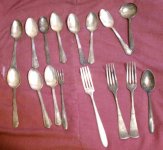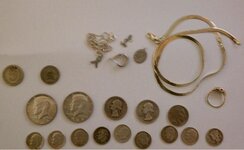sammerguy
Jr. Member
Hello everyone here at TN! New member here but i have been collecting "treasure" for a while now. Just recently I decided to look more into the whole MD hobby because of my somewhat better than average luck regarding the finding of coins and other valuables. All of the items I have found have either been found while thrifting,walking or just sorting change, almost never intentional. I hope to acquire a MD soon and do some searching when the weather gets more reasonable. I owned one a few years back that I got from "the shack" but it was really bad, no way to tell the difference between tabs and coins, just metal was there or not there(sometimes nothing at all even with a signal). I got rid of it shortly after purchasing it. I realize that it takes some time to learn your detector, but this thing was nothing but disappointment. So now I have some questions to ask about detectors.
1>Do the MDs that claim to differentiate between different metal types actually work? I'm OK with digging trash, but would like to be able to have a better idea of what MIGHT be there.
2>Is there a decent beginners MD in the 150-200$ range, or will any low price detector just show the presence of a metal object and not help me decide if the chances are good that it is an old item/coin? For instance, can it let me know with some reasonable accuracy if it is Aluminum,Iron,Copper etc.? Im not looking for the mother lode, I'm happy with old nails and bottles
Thanks in advance!
I have attached pics of some of my favorite items that have been found.
1>Do the MDs that claim to differentiate between different metal types actually work? I'm OK with digging trash, but would like to be able to have a better idea of what MIGHT be there.
2>Is there a decent beginners MD in the 150-200$ range, or will any low price detector just show the presence of a metal object and not help me decide if the chances are good that it is an old item/coin? For instance, can it let me know with some reasonable accuracy if it is Aluminum,Iron,Copper etc.? Im not looking for the mother lode, I'm happy with old nails and bottles
Thanks in advance!
I have attached pics of some of my favorite items that have been found.
Attachments
Upvote
0






 So there is really no way to tell aluminum from gold. All you can tell is various points on conductive scales, and combine that with your knowledge of your site, and your ears, and perhaps "play the odds" a bit.
So there is really no way to tell aluminum from gold. All you can tell is various points on conductive scales, and combine that with your knowledge of your site, and your ears, and perhaps "play the odds" a bit. I have done that before.......
I have done that before.......